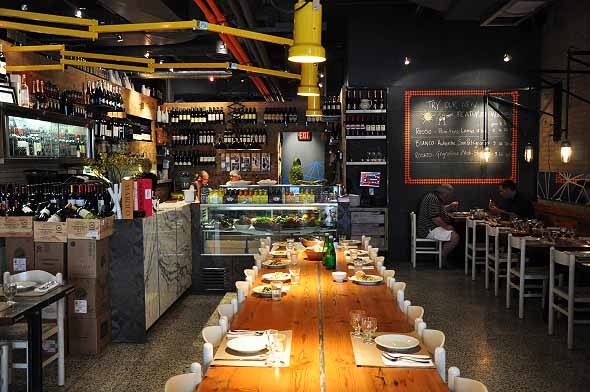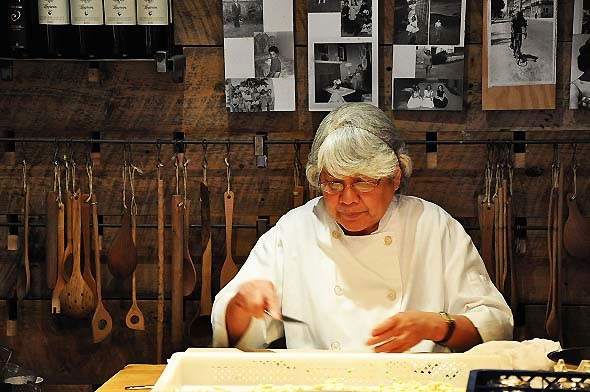Osteria Ciceri e Tria
Osteria Ciceria e Tria feels like a remote Southern Italian escape, far removed from the bustling financial district just blocks away.
Heralding our entrance are two sculptural relief lion heads high above the demure black and white awning. Through the double glass doors, we step into a style-conscious interior where modern architectural design collides with rustic Italian charm.
Exposed brick, unfinished wood planks and exposed air ducts give the interior a rigid industrial presence, which is softened by the country style furnishings and sentimental touches.
Owner Cosimo Mammoliti delicately ties in black and white family portraits, affixes common Italian names plates (including his own) to every table, along with a quirky course map of the
Giro de Italia to the main wall. Everything evokes a sense of family pride and is a true testament to his rich Italian heritage. Oversized canary yellow lamps shine upon the communal table, as if it were an architect's blank drawing board.
In the back end of the restaurant is

nonna

, mechanically hand pressing orrecchietti, pasta distinctive to Puglia. Sure, the setup is all a bit staged, but the fresh pasta is delicious and she's adorable to watch, so who can really blame them? A contemporary twist on a traditional Italian tavern, we start the meal with a sampling of assagini (small tastes). There is an intriguing play of flavours in the tapas-sized portions of five different dishes ($15 per person). We split a one-person order between the two of us.
The Carpaccio di Tonno, paper-thin slices of tuna with crunchy slivers of fennel are infused with fragrant mint and lemon, is a stark contrast to the Arrosto d'Agnello, a succulent fatty lamb stew. Similarly, Crostini cu l'Alice, marinated fresh anchovy with roasted bell peppers atop a crunchy wedge of baguette, has little in common with the Pitta di Patate, a savoury baked potato gratin. The single drawback to the medley is the dish of mini meatballs marinara, which bear a paste-like consistently.
We try a duo of pastas from the menu ($15). The Orrecchiette e Cime di Rapa, springy short pasta with fresh rappini, sardines, garlic, dusted with bread crumbs and is simply tossed in a high-quality olive oil.
The Ravioli di Branzino, seabass stuffed ravioli with clams arrives in a light seafood broth peppered with vegetables. Both pastas are daringly minimal, but equally successful in highlighting the flavour of each ingredient. The simplicity of these dishes remind me of home cooked meals from the Italian countryside, where fresh farm produce is combined with whatever else is at hand to create some truly memorable meals.
Our shared plate of Carpaccio di Purpo, octopus carpaccio with a beet side salad are also deceivingly simple. The sushi-quality octopus is sliced thin and doused in a strong olive oil with a citrus-scented potato salad. Both are subtle in flavour, and the chewy texture of the mollusk stands in nice juxtaposition to the starchy density of the boiled potatoes.
Clearly, there is a master blue print slowly being unveiled here. Through Chef Giovana Alonzi's subtle and innovative execution of classic home style cooking, Osteria Ciceri e Tria is taking cautious strides in distinguishing itself apart from the omnipresent Terroni enterprise.
Photos by Francis Jonas Yap.







